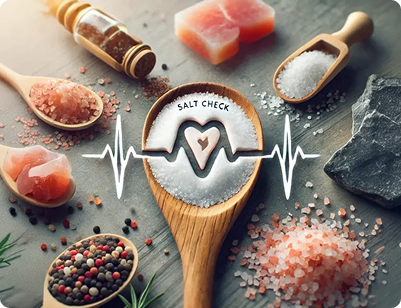
Salt Check: How to Master Your Sodium Game with Nature Fuel
Share
Let’s talk about something we all sprinkle without a second thought – salt. It’s the ultimate flavor MVP, the king of the kitchen, and honestly, the reason your fries taste so good. But here’s the twist: salt isn’t just about taste. It’s also a key player in keeping your body running smoothly. From thyroid health to brain function, salt (and specifically iodine) is kind of a big deal. So, how much is too much? And how do you strike the perfect balance between flavor and health? Let’s break it down.
The Scoop on Salt
Salt comes in many forms – table salt, Himalayan pink salt, kosher salt, black salt—you name it. Each has its own vibe, but when it comes to health, not all salts are created equal. The real star of the show? Iodized salt.
Why? Because iodine—a micronutrient found in iodized salt—is essential for your body. It’s like the behind-the-scenes director of your metabolism, brainpower, and even bone health. Here’s why iodine deserves a standing ovation:
● Thyroid Hormones: Iodine helps produce thyroid hormones, which regulate everything from metabolism to growth. Without enough iodine, your thyroid can go haywire.
● Brain Power: Iodine is crucial for brain and nervous system development. Think sharper focus, better coordination, and overall mental clarity.
● Bone Health: Skeletal maturation? Yep, iodine’s got that covered too. Low iodine levels can lead to stunted growth and weaker bones.
● Pregnancy & Infancy: For moms-to-be and growing babies, iodine is non-negotiable. It supports proper brain and bone development during these critical stages.
With all these perks, it’s no wonder iodized salt is having its moment in the spotlight.
How Much Salt Is Too Much?
Here’s the reality check: while iodine is essential, sodium (the main component of salt) can be a double-edged sword. The World Health Organization (WHO) recommends capping sodium intake at 2000 mg per day. But let’s be honest—most of us are way over that limit. Thanks to our love affair with chips, pizza, and processed snacks, the average American consumes around 2400 mg daily. Yikes.
Too much sodium doesn’t just make you feel bloated—it’s linked to serious health issues like high blood pressure, diabetes, and heart disease. On the flip side, too little iodine can cause problems like hypothyroidism, goiter, and fatigue. It’s a delicate balancing act.
Signs You’re Out of Whack
Not sure if your sodium or iodine levels are off? Here are some red flags:
● Low Iodine: Swollen thyroid glands, fluctuating weight, dry skin, constant fatigue, and brain fog.
● Too Much Iodine: Nausea, vomiting, diarrhea, and hyperthyroidism (yes, too much of a good thing can backfire).
The bottom line? Moderation is key.
How to Keep Your Salt Game Strong
Ready to take control of your sodium intake? Here are some easy tweaks to keep things balanced:
-
Swap Processed for Fresh
Processed foods are loaded with hidden sodium. Opt for fresh fruits, veggies, and homemade meals instead of frozen dinners, canned soups, and fast food.
-
Go Iodized
When seasoning your food, choose iodized salt. It’s fortified with the iodine your body needs without going overboard on sodium.
-
Read Labels
Keep an eye on sodium content in packaged foods. Look for options labeled “low- sodium,” “reduced-sodium,” or “no-salt-added.”
Final Thoughts
Salt isn’t the villain—it’s all about how you use it. By choosing the right type of salt, keeping tabs on your sodium intake, and supporting your body with smart supplements, you can crush your health goals without sacrificing flavor. Remember, small changes add up over time. So, next time you reach for the salt shaker, think balance, not binge
